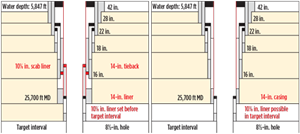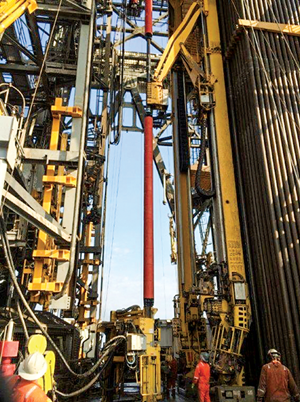Reducing the overall hookload weight of a landing string is key step in resolving restrictions to drilling deeper wells in deeper waters from existing rigs. A modular buoyancy system is enabling deployment of longer heavier casing and other downhole tubulars while reducing rig time, maximizing efficiencies and lowering costs. The system enhances operational safety for more flexibility in well design and rig class utilization.
Landing String Solutions’ landing string buoyancy technology uses specialized syntactic foam modules installed onto the casing landing string to provide a buoyant force that reduces the hookload of the drill pipe landing string. The enhanced foam enables operation in drilling mud and open water operations as opposed to only seawater.
DEEPWATER CHALLENGES
Increasingly difficult and demanding deepwater and ultra-deepwater wells present many well engineering and operations challenges. They require a variety of safe, new and reliable technologies to enhance drilling rig operational capabilities so that deepwater prospects can be cost effectively drilled.
Growing demand and more complex well designs are driving an operator focus on safety that involves either upgrading equipment or designing around current equipment limitations. While operators recognize the physical limitations of today’s mechanical systems and supporting structures, they are still aggressively pursuing new technologies with the potential to overcome current restrictions. However, it is becoming increasingly difficult to feasibly achieve objectives without incurring substantial costs or compromising operational safety.
CASE STUDY
In the Gulf of Mexico, the buoyancy technology has been run twice by two major operators to eliminate two liner tiebacks and run larger casing through the entire sub-salt section, Fig. 1. In the most recent run, the operator shortened rig time by two months and reduced the weight of the landing string by 206,996 lb. This weight reduction gave the rig the extra hookload to run the larger and longer casing that was desired. In addition, the rig safely landed the string, which practically eliminated the risk of exposure over time, while saving millions of dollars.
The buoyancy system was assembled onshore and loaded in purpose-built baskets for shipment to the rig. Custom-designed non-metallic clamps eliminate metal fasteners in the wellbore.
The installed technology significantly reduced rig time by safely reducing landing string weight, which allowed the rig to operate within its safe hookload limits, Fig. 2. The hookload reduction was achieved after the Landing String Solutions crew installed the system after running the 16-in. casing. The estimated hookload is from the final landing string solution tally just prior to running the landing string buoyancy system, Table 1.
REDUCING HOOKLOADS
Achieving high buoyancy uplift is critical for operators to justify the use of the technology. The amount of lift that can be achieved by this system is substantial and can be designed to offset the landing string weight by up to 80%, in some cases. The result is safer, more cost-effective deepwater operations, and depending on the well design, the elimination of a tieback step.
The landing string buoyancy system potentially enables operators to land a long casing string in the subsea wellhead versus running a shorter casing string (liner) and subsequent tieback liner due to the load limitations of the rig’s hoisting system. When running heavy casing strings and landing strings combined, the resulting static and operating dynamic loads should never equal or exceed a rig’s hoisting system.
The buoyancy system allows earlier generation MODUs to be used on some complex deepwater wells by providing a significant reduction in the load on its hoisting system. Because the hookload is reduced, the hoisting safety margin of all rigs can be increased. This application greatly expands the capability of a rig contractor’s fleet and could significantly reduce operators’ well cost. Reducing hookloads may decrease the frequency of detailed hoisting system inspections, leading to additional cost reductions.
COMPOSITE MATERIALS
The system utilizes all non‐metallic components while incorporating the latest syntactic and composite material technologies. A minimum 10-year service life allows for multiple deployments. Each element is designed to withstand a wide range of temperature and pressure extremes.
The core technology used in landing string buoyancy, syntactic foam, has been used for more than 40 years for various subsea buoyancy applications, from shallow water to full ocean depth. The main enhancement for landing string technology is that it is required to operate in drilling mud, as opposed to seawater but can be used in any open water operations.
While being submerged in the synthetic wellbore fluid environment, the buoyancy elements need added protection to contend with harsh chemicals, so a rugged, tough polyurethane coating encapsulates the syntactic foam to protect it from the harsh working environments while also protecting the elements from potential damage during handling or deployment.
The landing string buoyancy technology is installed offline at the ExPert Riser Solutions facility in Port Fourchon and loaded into custom transport containers to mirror running protocol, and loaded on the service vessel OSV with a 150-ton dockside crane. When the landing string is returned it is cleaned, disassembled and inspected.
CONCLUSION
Growing demand to drill deeper wells in deeper water with more complex casing designs and longer and heavier strings is driving operators to seek out new technologies with the potential to overcome equipment limitations of existing rigs. One proven technology is landing string buoyancy, which enables drilling contractors to deploy longer heavier casing and other downhole tubulars while reducing rig time, maximizing efficiencies and lowering costs. The overall benefits of this system range from enhanced operational safety to enabling more flexibility in well design and rig class utilization.
- Coiled tubing drilling’s role in the energy transition (March 2024)
- Advancing offshore decarbonization through electrification of FPSOs (March 2024)
- Subsea technology- Corrosion monitoring: From failure to success (February 2024)
- Digital tool kit enhances real-time decision-making to improve drilling efficiency and performance (February 2024)
- E&P outside the U.S. maintains a disciplined pace (February 2024)
- U.S. operators reduce activity as crude prices plunge (February 2024)
- Applying ultra-deep LWD resistivity technology successfully in a SAGD operation (May 2019)
- Adoption of wireless intelligent completions advances (May 2019)
- Majors double down as takeaway crunch eases (April 2019)
- What’s new in well logging and formation evaluation (April 2019)
- Qualification of a 20,000-psi subsea BOP: A collaborative approach (February 2019)
- ConocoPhillips’ Greg Leveille sees rapid trajectory of technical advancement continuing (February 2019)





